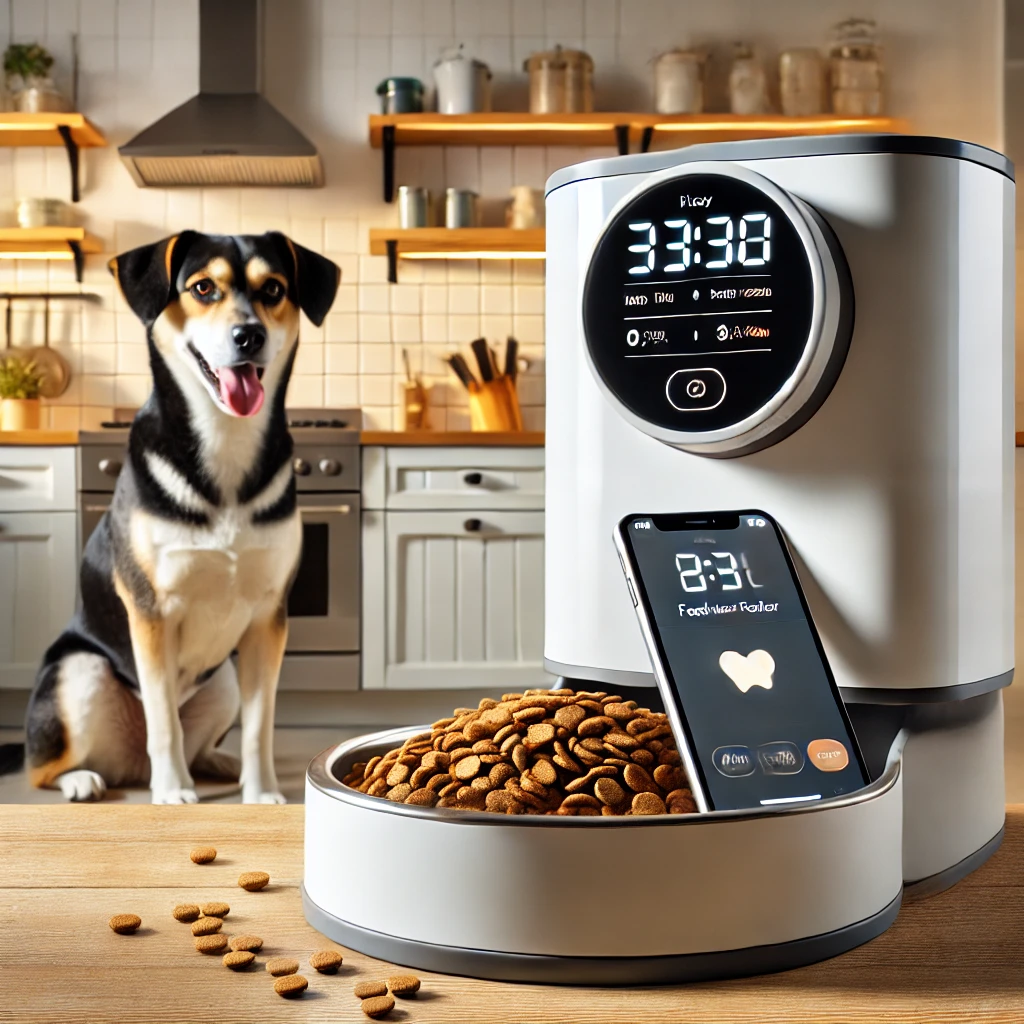
As pet owners, we understand the importance of keeping our furry friends on a consistent feeding schedule.
For many of us, busy workdays, travel, or life’s daily responsibilities can sometimes interfere with making sure our pets are fed on time.
That’s where a smart automatic dog feeder comes in.
Designed to simplify mealtime for both you and your dog, these feeders use cutting-edge technology to ensure your pet is well-fed even when you’re not at home.
In this guide, we’ll dive deep into the world of smart automatic dog feeders, exploring how they work, their benefits, and what to look for when choosing the best one for your dog.
We’ll also discuss different features and innovations that have transformed traditional dog feeders into tech-savvy solutions, making them a must-have for today’s modern pet owners.
The Evolution of the Automatic Dog Feeder
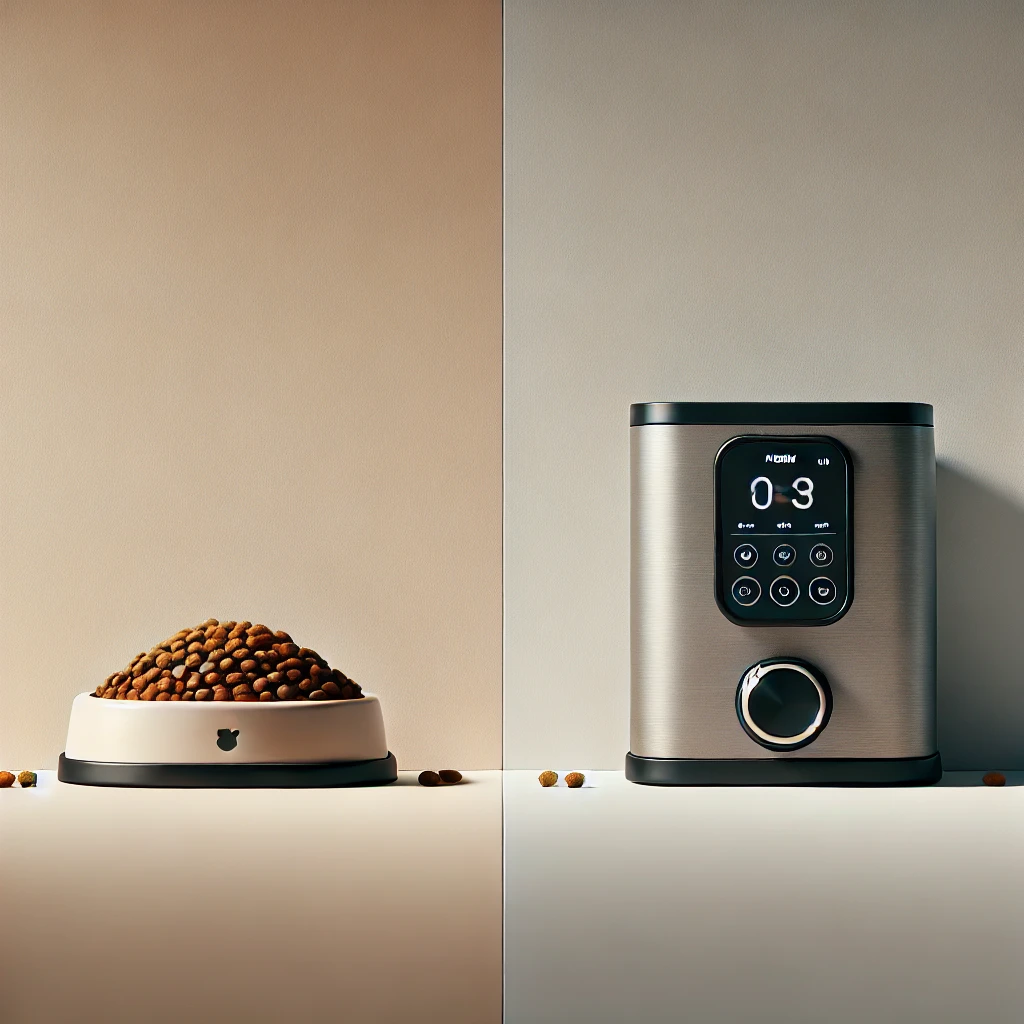
Pet care has come a long way over the years.
From basic food bowls to traditional timed feeders, we’ve always sought ways to make feeding our pets easier and more convenient.
Now, thanks to advancements in technology, the automatic dog feeder has evolved into a smart, tech-savvy device capable of providing a seamless mealtime experience.
Gone are the days when you had to rely on a friend or neighbor to ensure your dog was fed while you were away.
A smart automatic dog feeder gives you the power to control and monitor your pet’s mealtime through smartphone apps, voice commands, and other interactive features.
But how do these feeders work, and what makes them stand out from their traditional counterparts?
In this comprehensive guide, we’ll explore everything you need to know about smart automatic dog feeders, including their key features, how they benefit your dog’s health and routine, and the top models available on the market today.
Main Body: Understanding Smart Automatic Dog Feeders
How Does a Smart Automatic Dog Feeder Work?
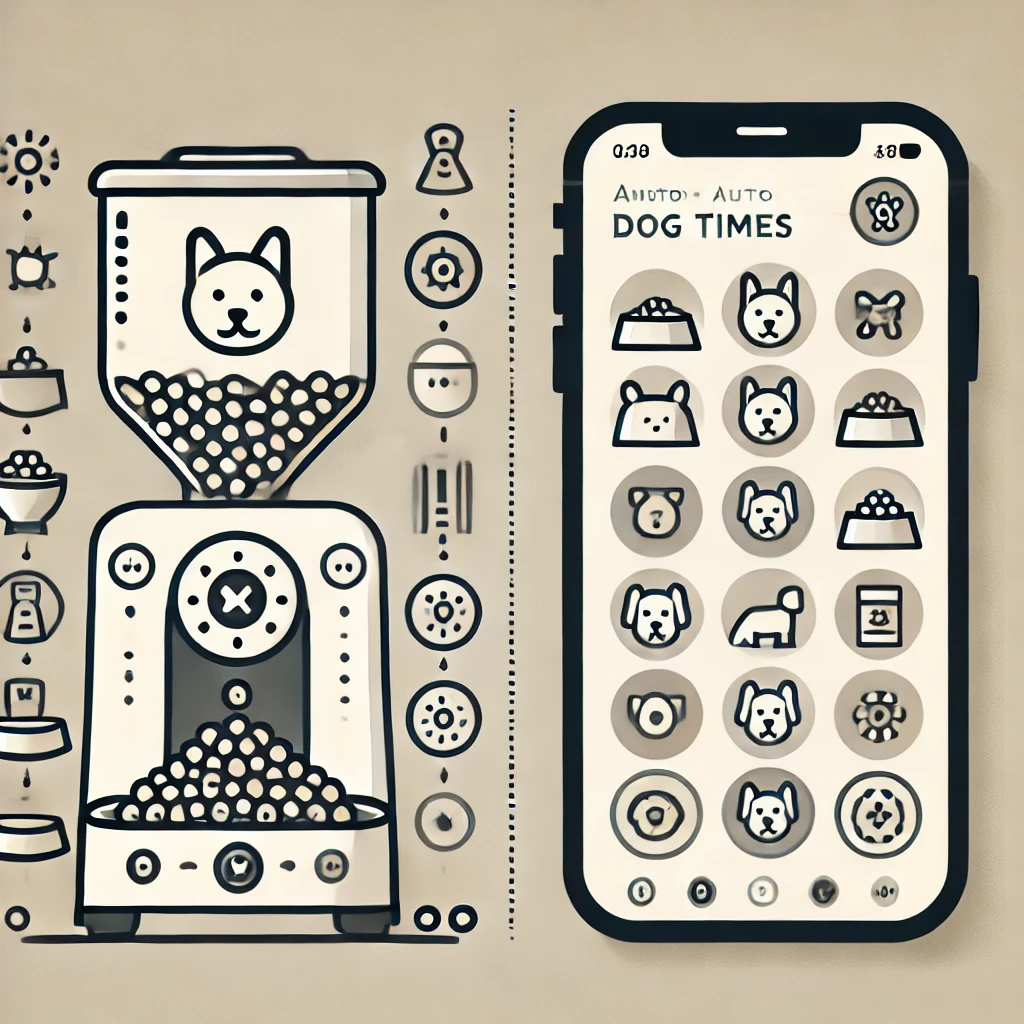
At its core, an automatic dog feeder is a device that dispenses a pre-measured amount of food to your dog at scheduled intervals.
Smart automatic dog feeders, however, go beyond just basic meal timing.
They are equipped with a variety of tech-forward features designed to provide more convenience and control over your dog’s mealtime.
Many of these feeders can be synced with smartphone apps, allowing you to program feeding times, portion sizes, and even monitor your dog’s feeding habits remotely.
Some models also feature integrated cameras, two-way audio, and voice command functionality, giving pet owners the ability to check in on their pets or communicate with them during mealtime.
Key Features of a Smart Automatic Dog Feeder
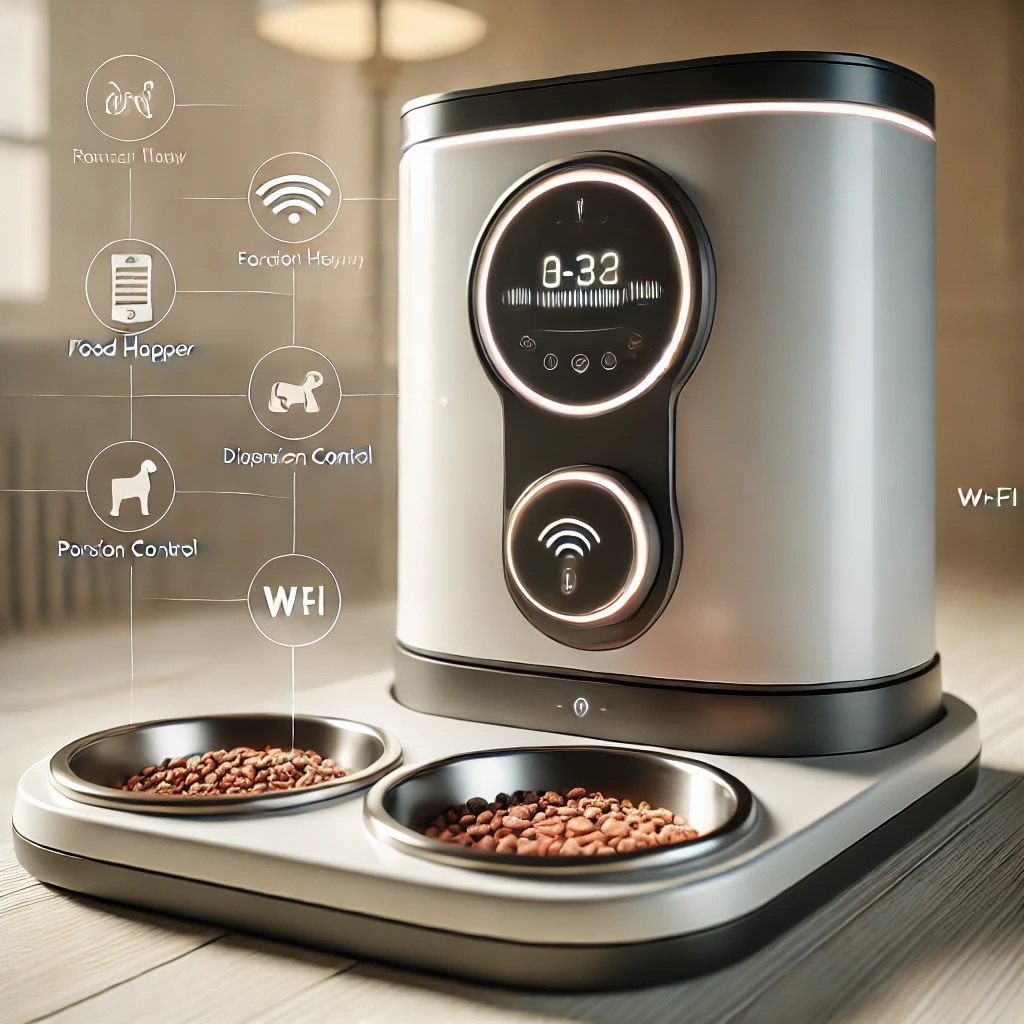
When shopping for an automatic dog feeder, there are several important features to consider:
- Smartphone Control: One of the most convenient features of a smart automatic dog feeder is the ability to control it from your phone. Through an app, you can schedule feedings, adjust portion sizes, and monitor when your dog eats, no matter where you are.
- Customizable Portion Sizes: Portion control is key for maintaining your dog’s health. Many smart feeders allow you to set specific portion sizes for each meal, ensuring that your pet gets the right amount of food each time.
- Multiple Feedings Per Day: If your dog requires smaller, more frequent meals, a smart automatic dog feeder can be programmed to dispense food several times a day. This is particularly helpful for pets with medical conditions or specific dietary needs.
- Wi-Fi and Voice Control: Some smart feeders are compatible with smart home devices like Amazon Alexa or Google Home, enabling you to control your dog’s meals with simple voice commands.
- Cameras and Two-Way Audio: Certain models come with built-in cameras that allow you to see your pet while you’re away. The two-way audio feature lets you talk to your dog, offering reassurance or even giving a command to sit before eating.
- Food Freshness Features: Many smart automatic dog feeders have airtight storage to keep kibble fresh and free from moisture. Some even have features like desiccant packs or notifications when the food supply is running low.
Benefits of Using a Smart Automatic Dog Feeder

There are several advantages to incorporating an automatic dog feeder into your daily routine, particularly one with smart technology.
Here’s how a smart feeder can benefit both you and your dog:
- Convenience for Busy Owners: One of the biggest perks of a smart automatic dog feeder is convenience. Whether you’re running late at work, on vacation, or simply busy with errands, you can ensure your dog gets fed right on time.
- Consistency in Feeding: Dogs thrive on routine, and a smart automatic dog feeder helps you establish a consistent feeding schedule. You won’t have to worry about missing a meal, which is especially important for dogs that need medication or specific dietary care.
- Weight Management: With the portion control feature, smart feeders can help prevent overfeeding, which is a common cause of weight gain in pets. Being able to program exact portion sizes ensures that your dog gets the right amount of food at every meal.
- Monitoring Eating Habits: Some feeders provide insights into your dog’s eating habits, such as when they’re eating and how much they consume. This can be particularly useful for pet owners monitoring health issues, like weight changes or appetite loss.
- Peace of Mind: With camera and audio features, a smart automatic dog feeder allows you to check in on your pet and interact with them during feeding times. This can be reassuring for both you and your dog, especially if they experience separation anxiety.
Choosing the Right Smart Automatic Dog Feeder
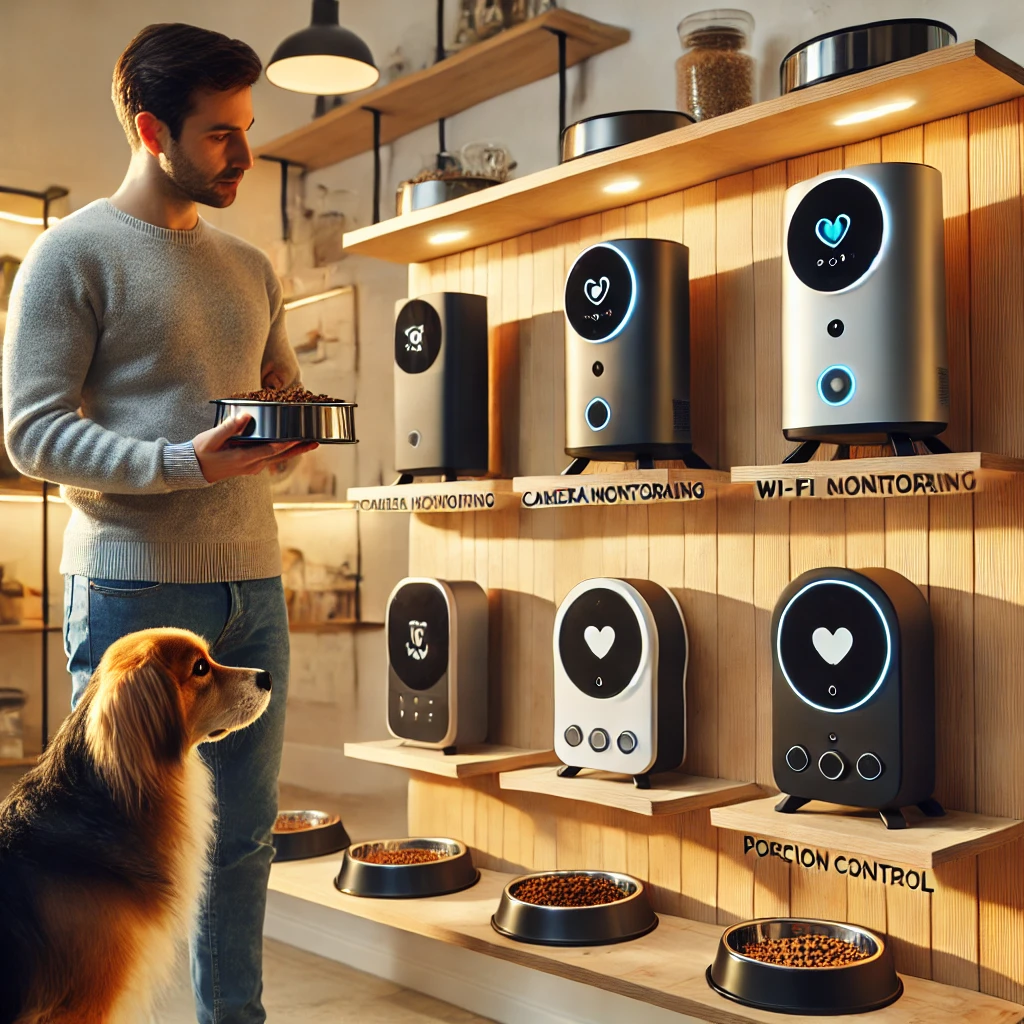
When selecting an automatic dog feeder, it’s important to consider your pet’s specific needs as well as your lifestyle.
Here are some factors to keep in mind:
- Size and Capacity: The size of the feeder and its food storage capacity should match your dog’s size and feeding schedule. Larger dogs or dogs that eat more frequently may require a feeder with a larger hopper.
- Power Source: Many smart feeders are powered by electricity but also offer battery backup, which is important in case of a power outage.
- Ease of Cleaning: Look for feeders with removable, dishwasher-safe parts to make cleaning easy. This helps maintain food hygiene and prevents mold or bacteria buildup.
- User-Friendly App: The app associated with the feeder should be easy to navigate, with clear options for setting feeding schedules, portion sizes, and other customizations.
- Additional Features: Decide whether extra features like a camera, two-way audio, or voice control are important to you. While these features can add convenience and fun, they also come with a higher price tag.
Popular Smart Automatic Dog Feeder Models
Here are some of the top smart automatic dog feeders on the market today, offering a range of features and price points:
1. PetSafe Smart Feed Automatic Dog Feeder
The PetSafe Smart Feed is a popular option, featuring Wi-Fi connectivity and a smartphone app that lets you manage mealtime from anywhere.
It allows you to schedule up to 12 meals per day and offers precise portion control.
The feeder is also compatible with Amazon Alexa, enabling voice-activated feeding.
2. WOPET SmartFeeder
The WOPET SmartFeeder comes with a built-in HD camera and two-way audio, allowing you to check on your pet and even talk to them during mealtime.
The feeder holds up to 6 liters of dry food, making it suitable for large dogs or multi-pet households.
The app lets you schedule meals and adjust portions, offering flexibility and convenience.
3. Petlibro Automatic Pet Feeder
The Petlibro Automatic Feeder is another top choice, known for its sleek design and user-friendly app.
It allows you to program up to 10 meals a day and adjust portion sizes with ease.
The built-in voice recorder also lets you record a personal message to play at feeding times, offering comfort to your dog when you’re not around.
4. DOGNESS Wi-Fi Automatic Feeder
The DOGNESS Wi-Fi Automatic Feeder features a large capacity food hopper and customizable feeding schedules.
It’s compatible with both iOS and Android devices, giving you full control over your dog’s feeding routine from anywhere.
The feeder also includes a camera and microphone, enabling you to keep an eye on your pet in real-time.
When Not to Use an Automatic Dog Feeder
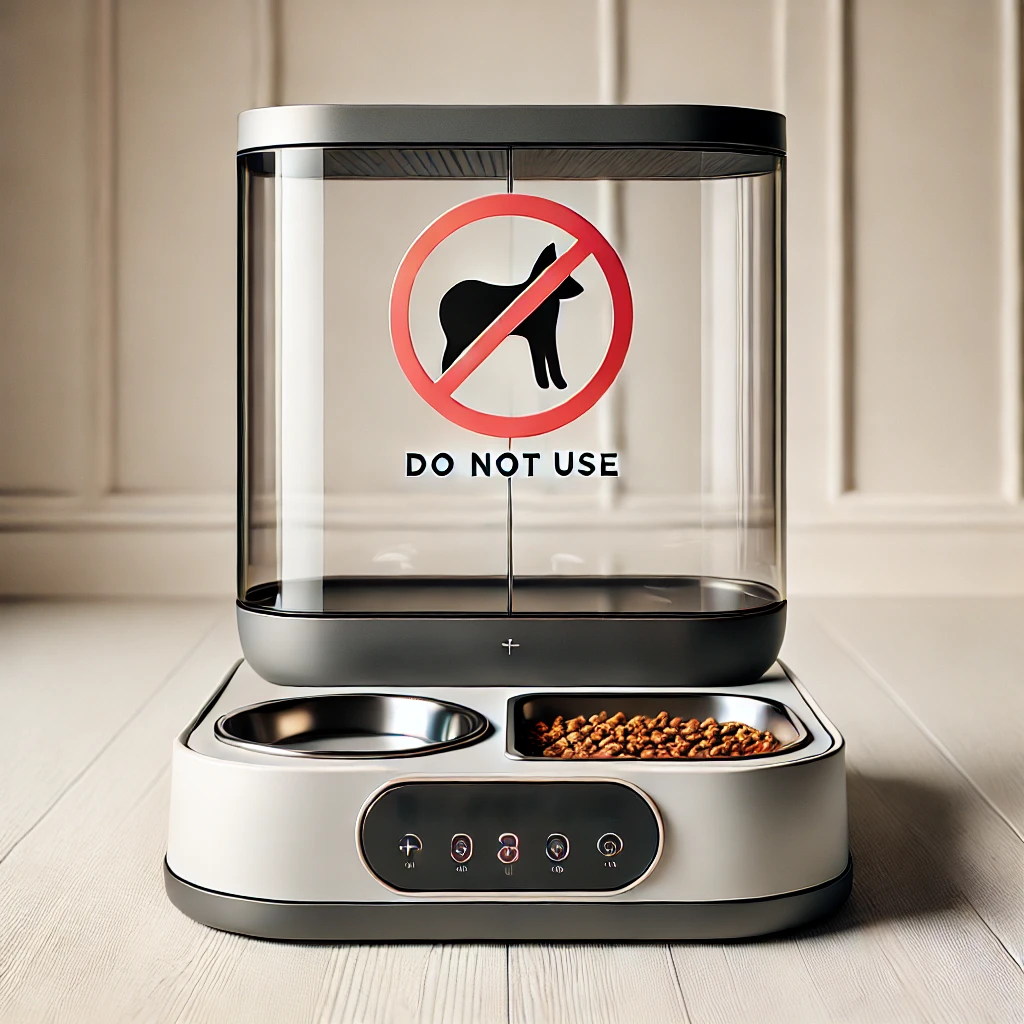
While a smart automatic dog feeder offers many conveniences, there are certain situations when it may not be the best option for your dog.
Understanding when not to rely on an automatic dog feeder is essential for ensuring the health, safety, and well-being of your pet.
Below are some scenarios where using an automatic dog feeder may not be ideal:
1. For Puppies or Dogs with Special Dietary Needs
If your dog is a puppy or has specific dietary requirements, such as prescription diets or wet food, an automatic dog feeder might not be suitable.
Puppies, for instance, require smaller, more frequent meals throughout the day, and their portions often need to be monitored and adjusted as they grow.
Wet or canned foods, which spoil more quickly than dry kibble, are generally not well-suited for automatic feeders, as most models are designed to dispense dry food only.
For dogs with health issues like diabetes or kidney disease, feeding times and portions need to be more carefully monitored, and some may need fresh or hand-prepared meals.
Relying on a smart automatic dog feeder in these cases could lead to nutritional imbalances or complications, particularly if the dog requires more personalized feeding management.
2. Dogs with Separation Anxiety
While automatic dog feeders can help with consistency, they may not be the best option for dogs that suffer from severe separation anxiety.
For anxious dogs, meal times can be moments of stress, and not having their owner around may exacerbate their anxiety.
While some smart feeders include voice recording or live chat features, these may not be enough to calm a particularly anxious dog.
In such cases, having someone physically present during feeding times can offer reassurance and alleviate stress.
Dogs with severe separation anxiety may also become destructive around the feeder or refuse to eat, especially if they associate mealtimes with their owner’s absence.
3. If Your Dog Free-Feeds or Grazes
Some dogs prefer to graze on their food throughout the day rather than eating set meals at specific times.
Automatic dog feeders are generally designed to dispense food at predetermined intervals, which may not suit dogs that prefer a free-feeding approach.
For dogs that eat small amounts of food sporadically, filling a traditional food bowl might be more appropriate than scheduling fixed feeding times.
Free-feeding may also be necessary for some dogs with medical conditions that require constant access to food, such as certain metabolic disorders.
In these cases, an automatic feeder that dispenses food in fixed portions may not align with their natural feeding habits.
4. In Multi-Dog Households
If you have multiple dogs with different dietary needs, an automatic dog feeder may cause more problems than it solves.
In households where dogs need different portion sizes or are on different feeding schedules, it’s challenging to ensure that each dog receives the correct amount of food from a single feeder.
Without supervision, one dog may consume another’s meal, leading to overfeeding or underfeeding.
In multi-dog households, it’s generally better to have separate feeding areas where you can monitor each dog’s intake.
Automatic dog feeders are most effective in single-dog homes or for dogs with similar feeding needs.
5. Dogs Prone to Overeating
Some dogs are known for their voracious appetites and will eat as much food as is available to them.
While automatic dog feeders with portion control settings can help regulate how much food your dog receives, some particularly clever dogs may find ways to break into the feeder and access additional food.
Certain models of automatic feeders are more tamper-proof than others, but dogs with strong problem-solving skills or determination might still manage to get extra food.
If your dog tends to overeat or has a history of attempting to access food outside of mealtimes, supervision or a more secure method of feeding may be necessary.
Feeding toys or puzzles that encourage slower eating may also be a better fit for dogs prone to eating too quickly or overeating.
6. When Food Freshness Is Critical
While many smart automatic dog feeders have airtight containers to preserve food freshness, they may not be ideal for long-term food storage or dispensing certain types of food.
For example, if you’re using fresh, wet, or raw food that spoils easily, an automatic feeder could pose a health risk as it may not keep the food in safe conditions for extended periods.
Dogs with sensitive stomachs or special diets may also require food to be served fresh, meaning that an automatic feeder dispensing dry kibble may not meet their dietary needs.
In these cases, feeding your dog manually or providing freshly prepared meals is the best way to ensure food safety and quality.
7. In the Event of Power Outages
If you live in an area prone to power outages or unreliable Wi-Fi connections, using a smart automatic dog feeder may not be the best option for consistent feeding.
While some models offer battery backups, these systems may not always be dependable, especially for long outages or if you are away for an extended period.
Additionally, smart features like Wi-Fi controls, camera monitoring, and app-based scheduling will be disrupted if the internet connection is lost, making it impossible to adjust feeding times or check on your pet remotely.
If reliable power and internet connectivity are concerns, it may be safer to use traditional feeding methods when you’re not at home.
Conclusion: Knowing When an Automatic Dog Feeder is Right for Your Pet
While smart automatic dog feeders offer incredible convenience and flexibility for many pet owners, they aren’t always the best option for every dog.
Puppies, dogs with special dietary needs, or those prone to separation anxiety may benefit more from personalized feeding care, while multi-dog households and free-feeding dogs may face challenges with the structured nature of automatic feeders.
Understanding your dog’s specific needs and behavior is key to determining whether an automatic dog feeder is the right choice.
In some cases, a combination of traditional feeding methods and smart technology may provide the best solution for your pet’s health and well-being.
By carefully assessing your dog’s requirements, you can make an informed decision that ensures they are well-fed, happy, and healthy.
Conclusion: Why a Smart Automatic Dog Feeder is a Game Changer
In today’s fast-paced world, balancing work, travel, and pet care can be challenging. A smart automatic dog feeder is an excellent solution for ensuring your dog is fed consistently and on time, even when you can’t be there.
With features like smartphone control, portion customization, cameras, and voice commands, these tech-savvy devices are designed to make life easier for both you and your pet.
Choosing the right automatic dog feeder for your dog can not only improve their mealtime routine but also give you peace of mind, knowing that they are well cared for no matter where you are.
From maintaining portion control to keeping your dog on a strict schedule, these feeders offer a level of convenience that traditional feeders simply can’t match.
If you’re a busy pet owner or someone who enjoys integrating smart home technology into your daily life, investing in a smart automatic dog feeder might be the perfect next step for you and your furry companion.
With so many options on the market, there’s a feeder for every type of dog and owner, making it easier than ever to ensure that your pet gets the best care—even when you’re away.
FAQ: Automatic Dog Feeders

Here’s a list of frequently asked questions about smart automatic dog feeders to help you better understand how they work and how they can benefit both you and your pet.
1. How does an automatic dog feeder work?
An automatic dog feeder works by dispensing pre-measured portions of food at scheduled intervals.
You can program the feeder to dispense food at specific times of the day, ensuring your dog gets fed regularly even when you’re not home.
Smart feeders connect to your smartphone, allowing you to control feeding remotely through an app, adjust portion sizes, and even monitor your dog’s eating habits in real-time.
2. Can I control an automatic dog feeder from my phone?
Yes, many smart automatic dog feeders come with apps that allow you to control feeding schedules, portion sizes, and more from your phone.
Some feeders are also compatible with smart home devices like Amazon Alexa or Google Assistant, which allow you to feed your dog through voice commands.
3. What type of food can I use in an automatic dog feeder?
Most automatic dog feeders are designed to dispense dry kibble, as it is less likely to spoil and easier to measure.
Some models are equipped to handle a variety of kibble sizes, but they may not work well with wet, raw, or fresh food due to spoilage concerns.
If your dog requires fresh or wet food, an automatic feeder may not be the best option.
4. How often should I clean the automatic dog feeder?
It’s essential to clean your automatic dog feeder regularly to prevent food buildup, mold, or bacteria.
Many feeders come with removable parts that are dishwasher-safe, making cleaning easy.
It’s recommended to clean the feeder at least once a week, or more often if your dog eats multiple times a day, to maintain hygiene and food safety.
5. Will my dog overeat with an automatic feeder?
Most automatic dog feeders are designed with portion control features, allowing you to dispense specific amounts of food at each feeding.
However, some dogs may still try to access extra food if the feeder is not tamper-proof.
Be sure to select a model that is secure and suitable for dogs prone to overeating or attempting to break into the feeder.
6. Can I use an automatic dog feeder for multiple pets?
Using a single automatic dog feeder for multiple pets can be challenging, especially if they have different dietary needs or portion sizes.
Some smart feeders allow for separate feeding schedules, but it’s important to ensure that each pet gets the right amount of food.
For multi-pet households, it may be better to use individual feeders for each pet.
7. What happens if the power goes out?
Many smart automatic dog feeders come with a battery backup to ensure that your dog gets fed even if there’s a power outage.
It’s important to check that the feeder you choose has this feature, as it will prevent disruptions to your dog’s feeding schedule in the event of a power failure.
8. Can I schedule multiple meals a day?
Yes, most smart automatic dog feeders allow you to schedule multiple meals per day.
This is especially useful if your dog needs to eat smaller, more frequent meals.
You can program specific times and portion sizes for each meal directly through the feeder’s app.
9. Will my dog still need supervision during mealtime?
While an automatic dog feeder helps you ensure your dog gets fed on time, supervision is still recommended for dogs with specific health concerns, those prone to overeating, or those with behavioral issues around food. Automatic feeders are a great tool for convenience, but it’s always a good idea to monitor your dog’s eating habits, especially if they have medical needs or dietary restrictions.
10. Is it safe to leave my dog with an automatic feeder while I’m away for a long period?
If you’re going to be away for an extended time, an automatic dog feeder can be a helpful tool to ensure your dog is fed, but it should not be the only care your dog receives.
Dogs also need fresh water, bathroom breaks, exercise, and companionship, so it’s important to have a trusted person, like a pet sitter, check in on your dog regularly.
By understanding the ins and outs of an automatic dog feeder and knowing when and how to use it, you can give your dog the care they deserve while enjoying the convenience and peace of mind that technology offers.
Related Articles:
Is an Electric Fence for Dogs Right for Your Pet? Pros and Cons Explained
Dog Treadmill vs. Outdoor Walks: Which Is Better for Your Pup?
As an Amazon Associate, I earn from qualifying purchases.


